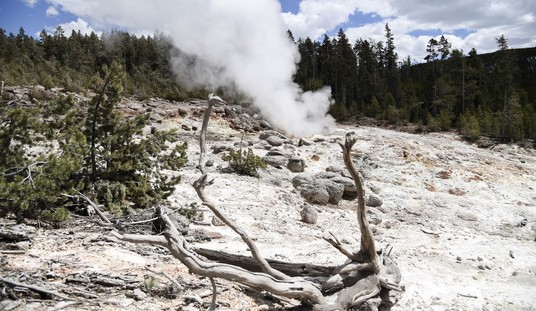For better or worse, I’ve always seen things a little differently, slightly skewed, maybe.
That made my high school freshman Algebra experience a living hell, both years of it. I finally got through by doing problems two ways. One was the way that made sense in my mind, which was inevitably wrong. Then, I did it the opposite way that made no sense to me, but was actually correct. True story.
My kindly Algebra teacher approached my parents after Finals and whispered, “We got him through.”
I went on to study journalism at university. Not today’s style of journalism with stories cooked according to a partisan agenda that fits neatly into a pre-approved ideological narrative.
But stories that relied on original, honest reporting that attempted to cover all sides fairly. So, I was quite curious about the assignment to read a book called “Unobtrusive Measures.”
It was actually written to teach sociologists to approach research in a nontraditional manner. Not just data or interviews. But examining things like other people such as Sherlock Holmes did, walking into a room, observing the tiniest detail others had missed, and deducing an entire crime just by looking around.
You could call that skewed — my style.
We had a long class discussion, which I do not remember.
The ensuing assignment was to pick a subject, report it in a traditional way, and then write a standard feature.
Next, we were told to go cover the same subject using the unobtrusive measures approach, looking for things that weren’t apparent in standard reporting, then exploring where they led and what that revealed.
That was right up my skewed rookie alley.
I chose the Museum of Science and Industry on Chicago’s South Side near Lake Michigan.
I have not been there in many years, but it had captured my youthful imagination in previous visits with its creative exhibits, actual rides inside the mammoth building, and, of course, the captured German U-boat 505.
I’m going to compress the story of this story because the experience was a seminal one for me that I used many times in my news-writing career. But it might seem pedestrian to others. I wrote here recently about a later journalism lesson I acquired in Belgium.
I set up an interview with the museum director and some department heads. I got all the numbers — annual volume of visitors, budget, revenues, employees, that sort of stuff.
He was very helpful and patient as I scribbled down my notes. Naturally, I asked him what was the most popular attraction in the museum.
He pulled a bulging file from a drawer and told me it was the Coal Mine Train, an actual jerky ride through a faux dark coal mine in a little gondola.
He showed me the stat sheets, and sure enough, for years, the Coal Mine Train Ride was by far the most popular exhibit according to ticket sales.
I returned to my room and banged out a standard feature story about the unique institution founded in 1933. It was the kind of piece you might find in an old newspaper travel section, if they still had them, and didn’t need to include warnings about random shootings, street crime, and flash-lootings of stores.
It contained the hours of operation, ticket prices, some descriptive paragraphs, information on the least-crowded days and, of course, quotes from the director about the history and the most popular activity there.
You won’t be surprised to learn that it was not the actual German submarine there. It was the Coal Mine Ride, which I rode.
(If I was writing it today, I could note that at certain times of the year, visitors actually can stay A Night at the Museum, just like the movies. )
That done, I scanned the underlined passages in my “Unobtrusive Measures” book and returned to the museum as an aspiring journalistic Sherlock Holmes. I gotta say that was some kind of fun.
I noted where the crowds were; it wasn’t the Coal Mine Ride.
I interviewed a number of visitors about their experiences; children had different favorites than the adults.
I also tracked down the janitors. I asked them where the carpets wore out the quickest, where the trash cans filled fastest, where the exhibit glass shields needed the most frequent cleaning. And were there any doors that required maintenance more often?
Sure enough, as the book predicted, the unobtrusive findings were different than the standard ones.
The carpets wore out quickest, the trash cans filled fastest, and exhibit windows got smeared worst all in the exact same area that was always the most crowded.
It was the exhibit with the heat lamp on chicken eggs hatching right in front of visitors’ eyes.
New life magically emerging from within slowly cracking egg shells, and wet chicks stumbling about. You could hear the oohs and aahs when a new cycle of life began.
There were no revealing stats to show this. No separate tickets to count. Families came and went and returned all day long to see if anything new was happening.
But the janitors knew what the most popular exhibit was. And I've often wondered since, were both versions true, or was one truer than the other?
I used this approach often during the long years of my reporting career. Turned out, sometimes the unobtrusive measure to notice was actually something that was missing.
On my many work and family trips through the rural Heartland over time, I had noticed that no one was sitting on the covered front porches that adorn the front and sometimes both sides of most old homes. The stately homes lined both sides of small-town side streets that had no curbs and often no street signs because why bother? Everyone who needed to know their names already knew them.
People might even sit on those porches during a rainstorm to feel the refreshing breezes, smell the wet grass, and time the thunder.
I used to sit on my grandparents’ front porch most summer nights. Neighbors passed by on evening strolls along the sandy path, all waving, some pausing to chat a bit. It was pleasant and relaxing. Most importantly, it was a reassuring time for everyone living nearby to feel connected as a community, everyone knowing that yet another day had passed according to a familiar, valued rhythm.
My grandparents’ old home is gone now. Their farm is covered with condo apartments with tiny balconies jutting out.
I did some research with architects. They told me no one wanted public front porches anymore. Air-conditioning and television had lured most everyone inside — or out back.
People cared less about the old-fashioned community connections. They wanted private decks away from noisy streets behind their air-conditioned abodes where the grill and sometimes even a TV were.
I wrote a story from Nora Springs, Iowa — here it is — to describe a quiet change that had crept across America at that time without any public notice.
The American front porch—long a treasured site for rocking, sipping, swinging, courting, gossiping, and plain old watching—is dying a painfully slow death, the victim of air‐conditioners, television, and a shifting society.
You could call that an unobtrusive measure.
And you could call me an amateur Sherlock.
________________________
This is the tenth in an occasional series of Memories that RedState editors suggested I share. Feel free to share your own relevant memories on today's post in the Comments below, as many others have on previous Memories. I hope you enjoyed this and will pass it on to others. Follow me @AHMalcolm
Other Recent Memories:
When Hal Holbrook Took a Day to Tutor a Teen on Art













Join the conversation as a VIP Member